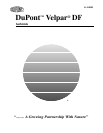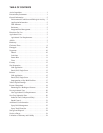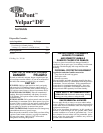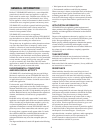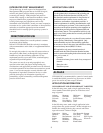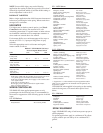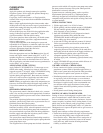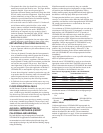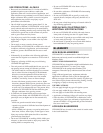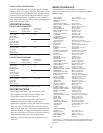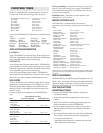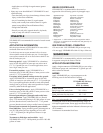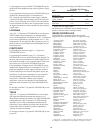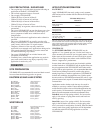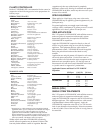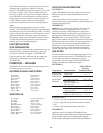
• The printed side of the sign should face away from the
treated area towards the sensitive area. The signs shall be
printed in English. Signs must be posted prior to
application and must remain posted until foliage has dried
and soil surface water has disappeared. Signs may remain
in place indefinitely as long as they are composed of
materials to prevent deterioration and maintain legibility
for the duration of the posting period.
• All words shall consist of letters at least 2 1/2 inches tall,
and all letters and the symbol shall be a color which
sharply contrasts with their immediate background. At
the top of the sign shall be the words “KEEP OUT”,
followed by an octagonal stop sign symbol at least 8
inches in diameter containing the word “STOP”. Below
the symbol shall be the words “PESTICIDE IN
IRRIGATION WATER”.
• Posting required for chemigation does not replace other
posting and reentry requirements for farm worker safety.
REPLANTING (FOLLOWING ALFALFA)
• Do not replant treated areas to any crop except corn, root
crops or sugarcane within two years after treatment, as crop
injury may result.
• Corn may be planted 12 months after the last treatment in
areas of moderate to high rainfall (greater than 20 inches),
provided the use rate did not exceed 1 lb per acre.
• Root crops such as potatoes, sugarbeets, radish and carrots
may be planted 12 months after last treatment, provided the
use rate does not exceed 2/3 lb per acre. Sites with use
rates higher than 2/3 lb per acre should not be replanted to
any root crop within 2 years after application of DuPont™
VELPAR® DF, or unacceptable crop injury may result.
In areas where irrigation is needed to produce the crop, the
crop rotation intervals listed may need to be extended if the
normal irrigation amount is reduced for any reason.
• Sugarcane may be planted any time following treatment.
• In California, do not replant seed alfalfa areas to any crop
within two years after treatment, as crop injury may result.
FLOOD IRRIGATED ALFALFA
In arid climates (10 inches of rainfall or less per year) or areas
where drought conditions have prevailed for one or more
years, a field bioassay should be completed prior to planting
any desired crop. The results of this bioassay may require the
rotation intervals listed above to be extended.
A successful bioassay means growing to maturity a test strip
of the crop(s) intended for production. The test crop(s) strip
should cross the entire field including knolls, low areas, and
areas where any berms were located.
ALFALFA - IMPREGNATION ON
DRY BULK FERTILIZER (EXCEPT
CALIFORNIA AND ARIZONA)
Dry bulk fertilizer may be impregnated or coated with
VELPAR® DF for application to established alfalfa. All
recommendations on this label must be followed along with
state regulations relating to dry bulk fertilizer blending, impreg-
nating and labeling.
If fertilizer materials are excessively dusty, use a suitable
additive to reduce dust prior to impregnation, as dusty fertilizer
will result in poor distribution during application. The dry
fertilizer must be properly impregnated and uniformly applied to
the alfalfa to avoid crop injury and/or poor weed control.
To impregnate the fertilizer, use a system consisting of a
conveyor or closed drum used to blend dry bulk fertilizer. Any
commonly used fertilizer can be impregnated with VELPAR®
DF, except potassium nitrate or sodium nitrate. Do not use
VELPAR® DF on limestone.
Use a minimum of 250 lb dry bulk fertilizer per acre and up to
a maximum of 450 lb per acre. To impregnate or coat the dry
bulk fertilizer with VELPAR® DF, mix 2 2/3 pounds of
VELPAR® DF with sufficient water to make one gallon of
suspension and thoroughly agitate. Direct the nozzles to
deliver a fine spray of this suspension toward the fertilizer for
thorough coverage while avoiding spray contact with mixing
equipment. Uniform impregnation of VELPAR® DF to dry
bulk fertilizer will vary, and if the absorptivity is not
adequate, the use of an absorptive powder may be required to
produce a dry, free-flowing mixture. “Microcel E” is the
recommended absorbent powder. When another herbicide is
used with VELPAR® DF, mix and impregnate the fertilizer
immediately.
Apply impregnated fertilizer as soon as possible after impreg-
nation for optimum performance.
Select the rate of VELPAR® DF to apply per acre from the
appropriate section of this label. Then refer to the rate chart
below to determine the amount of VELPAR® DF that should
be impregnated on a ton of dry bulk fertilizer, based on the
amount of fertilizer to be distributed in one acre.
Rate Chart for Impregnating Fertilizer with VELPAR® DF
Fertilizer VELPAR® DFRate PerAcre
Rate/Acre 2/3 Lbs 1 Lbs 1 1/3 Lbs 2 Lbs
250 lbs 5.3 lbs/ton 8.0 lbs/ton 10.6 lbs/ton 16.0 lbs/ton
300 lbs 4.4 lbs/ton 6.6 lbs/ton 8.8 lbs/ton 13.3 lbs/ton
350 lbs 3.7 lbs/ton 5.7 lbs/ton 7.5 lbs/ton 11.4 lbs/ton
400 lbs 3.3 lbs/ton 5.0 lbs/ton 6.7 lbs/ton 10.0 lbs/ton
450 lbs 2.9 lbs/ton 4.4 lbs/ton 5.9 lbs/ton 8.9 lbs/ton
For rates other than those listed, use the following formula to
calculate the amounts of VELPAR® DF to be impregnated per
ton of dry fertilizer.
Lbs Lbs
VELPAR® DF X
2000
= VELPAR® DF Per
Per acre
Lbs Fertilizer Per Acre
Ton of Fertilizer
APPLICATION
Uniform application of VELPAR® DF-impregnated dry
fertilizer is essential for satisfactory weed control. Accurate
calibration of the application equipment is essential for
uniform distribution to the surface. The recommended
method of application is to apply 1/2 the recommended rate
and overlap 50%. This results in the best distribution
pattern.
6



